in Layman’s terms
2019 UPDATE: Our friends made a very concise video about AI (much better than we could ever make…) so here’s a link to their video:
The basics to know before we start:
- Do not compare cows with humans – reproduction works very differently in cattle!
- A dairy cow comes into heat around every 21 days (19-21 days).
- Jersey heifers tend to mature at the earliest age, having their first heat around 5-6 months old. Other dairy breeds and beef breeds may take up to several months longer to start. Puberty generally occurs when a heifer is around 30 to 40 percent of her predicted adult weight.
- TIP: Due to the early maturity of many dairy heifers, a good rule is to never keep a bull of any age with female cattle, unless you want those females bred! (We have visited farms with “milking yearlings” that must have been bred around 7 months old according to our math! Beware of bulls jumping fences!)
- The average first calving age for dairy heifers is at age two. Jerseys, being early maturing and having the smallest birth weight calves, are sometimes bred at younger ages. Commercial farms may regularly breed their heifers at one year old, which would calve them at 1 year 9 month (or 21 months) old. For a family cow, safety and risk reduction easily justify waiting until at least two years old for first calving! To calve around two years old, you would want to look for the heat cycles nearest the heifer’s age of 15 months old. First breeding age of a heifer can safely range from 14 to 19 months old. The latest maturing dairy breed that we know about is Brown Swiss, where many farms have their mammoth cattle calving near three years old for the first time.

- Can you wait to breed your Jersey to calve at 3 years or older? By chance or by design, some early maturing cattle may not settle easily, may lose a term calf, or perhaps she is just not taking after several breedings. While this does happen, breeding for older first calving age is not desirable in most dairy animals. Similar to the reasons why you do not ever want a dairy cow to be fat, a late bred heifer will tend to build up fat (dairy breeds collect fat around their organs, unlike beef that collect fat in more exterior locations on their body). This fat can lead to complications around calving time. Also, from what we have observed, older calvers seem to milk proportionately more, maybe due to their increased maturity/size, and the stress of milking stresses them that much more. First calving is difficult enough, but “old age” stacks on that to increase risk.
- After calving, cows come into heat as soon as 10 days post-calving, although commonly more like 30-60 days later, and some as late as 100 days out. Spring weather and new sunshine tend to bring on heats that the cold winter may have repressed. Extra hot summer weather, a cow that is too thin, or a cow that is “cystic” are reasons why a cow might not show signs of heat.
- Some healthy cows are able to be bred on their first heat, but we do not recommend this! Cows should at very minimum have that first good heat cycle to cleanse their internal system. The next heats that a cow has before she is bred will help to maintain and strengthen her reproductive system so that when you do want to breed her, hopefully she is ready and receptive.
- A cow is generally re-bred around 90-120 days post-calving. As the chart below indicates, dairy cattle are usually kept on a one year calving rotation. WHY? 1. Freshen milk supply, 2. Keeps cow in healthy, productive condition, 3. Provides opportunity for income from calf.
More information: Penn State article on Heat Detection and Timing of Insemination for Cattle
Progressive Dairyman article: Heat Detection
Identifying Heat Cycles:
Before you worry too much about what a heat looks like, emphasis must be put on keeping records! An easy way to record suspicious behavior or verified heats is to mark the day on your wall calendar “Miss Moo – in heat today – jumped on me” or if you have a record book for your animals, consider making a page where you record heat cycles. Then, you can count 21 days from that day and know to watch for another heat cycle – and if you see it, you know you’re on the right track to identifying how your animal “shows” heats! I just found a “21 day” calendar, which can be helpful in counting days:
2014 Calendar in 21 day intervals for tracking heats:
For example, we had a heifer in heat on February 8.
Sure enough, we woke up the morning of March 1st and she was in heat again.
We bred her March 2 and if she doesn’t take to that breeding,
we will watch for her to come into heat on March 22:
Several months in advance, start looking for someone who has the knowledge, ability, and tools to help you get your cow bred. In this modern age, there are not a whole lot of people who have the knowledge of how to artificially breed a cow, especially in non-dairy parts of the country.
WHAT DOES A.I. MEAN?
A.I. stands for “Artificial Insemination” and is basically summed up as being a middle man. First (in a non-graphic description) semen is carefully collected from a bull (also called “sire”) and is then put into small straws that each hold ¼ to 2 cc’s of semen. Doesn’t sound like much, but that can be millions of sperm!! These filled straws MUST be ALWAYS kept in liquid nitrogen (a cool –320 degrees F, yes negative!) Kept properly, they can last decades. We still have glass ampules of semen from the 1950’s and straws from the 1960’s that have successfully bred a cow who 9 months later birthed a live calf. Amazing stuff! The second step is to ship the semen (in storage nitrogen tanks) to semen representatives and technicians. They keep their equipment and tools handy and can travel by vehicle to your farm to breed your animal. That is step three, which we’ll get into later (see below a few paragraphs…)
WHERE TO FIND AN A.I. TECH:
- Local newspaper advertisements
- Craigslist
- A.I. companies (online directories, or call nearest representative)
- Local dairy farmers (who may know of someone, or may be willing to help you by sharing their own equipment)
- Be aware, for a number of reasons, they may say no, they cannot help you. Worse, they may offer to help and then never be available when you need them. Be courteous, but also see if you can find a back up in case your first option does not work out!
WHAT TO ASK WHEN YOU FIRST CALL:
- Introduce yourself, briefly state why you are calling, what breed of animal you have, approximately when you think you will want them bred.
- Location: How far of a distance between technician and farm? Feasible? Is tech going to have to charge mileage if the distance is further away?
- Is the tech usually available/flexible to come when you need them or do they have limiting factors such as a day job that may interfere with timing?
- Cost: Is there a flat rate for every visit or are rates adjusted based on first, second, third breedings? Does the cost of breeding include semen or do you have to purchase that separately?
- Semen options:
- What does the tech currently have available?
- Do they work with any particular companies; which?
- *If you want something they do not have in stock, order ahead!*
- LEARN MORE ABOUT BULL SELECTION BY CLICKING HERE!
- Thank you, I will keep your number handy and call you as soon as I see signs of heat!
WHAT IS NORMALLY CHARGED FOR A.I. SERVICE?
Anything’s possible, but below is a list of a few real life options available in our area, and should be somewhat similar to what you find in your area:
|
Technician |
First Breeding |
Repeat Breedings |
Mileage |
Semen cost |
|
#1 |
$40 |
$25-40 |
Up to $60 |
Included, except specialty semen |
|
#2 |
$70 |
$30 |
Up to $50 |
Included |
|
#3 |
$50 |
$50 |
Up to $50 |
Not included |
HOW MUCH DOES SEMEN COST?
If you want to buy semen from a particular bull, say you have your heart set on breeding your cow to a Dutch Belted bull, the general rule is that semen comes in units of 10 because they are packaged that way. You will see a cost per unit (example: $18 per unit) but expect to pay $18 x 10 = $180. Rarely, the semen sales company may allow you to buy only 5 units. Your option for buying lesser amounts is to buy something from a dairy farmer or use something your A.I. tech has in stock.
|
Type of Semen |
Average/Range of Cost per Straw |
|
Home Collected – bulk |
$3-10 |
|
Young Sire |
$5-20 |
|
Active Sires |
$12-25 |
|
Sexed Semen |
$35-55 |
|
Specialty/Rare |
$100+ |
|
Embryos |
$100-500 |
CAN I JUST BREED MY COW BY DOING A.I. MYSELF?
Sure, Select Sires offers courses to learn the A.I. process. Check online (www.selectsires.com) for locations and cost. Also, some vets or A.I. techs may be willing to teach you some or all of the process.
SO WHY DON’T MORE PEOPLE DO THEIR OWN?
#1 reason: Cost of equipment and supplies.
|
Equipment/Supply |
Cost New/Used |
|
Liquid Nitrogen Tank |
$300-1200 |
|
A.I. Kit |
$150 + refills |
|
Semen Collection |
$70 to $500+ per bull |
|
Liquid Nitrogen |
$40-60 per refill (every 50+ days) |
#2 reason: Experience – To be successful in breeding cows, a lot of practice is required. Most people do not have access to large herds where they can practice and become skilled. Saving a few dollars would not add up if it meant repeat breedings or damaging the inside of the cow due to inexperience.
On a positive end note, if you have the financial resources to set up a business, access to teachers and experience, and a good sized potential client base, this could provide a nice side income for a farmer.
HOW ABOUT I JUST USE A BULL?
#1 reason: Bulls are dangerous animals. They require their own highly secure pen, and if you hear stories from the good ole days when most farms kept a bull, I bet you have also heard stories about men being gored to death by “that bull that was always nice and just turned one day”… Plus, if you keep your own bull, they have their own costs associated with housing and feed.
Using a bull of your own generally only makes sense if you have a good sized herd (several breeding cows) and proper facilities.
If you know someone nearby that has a bull available, there is also the option of taking the cow to the bull to be bred (if she will accept him, and travel is not good for encouraging pregnancy). Heifers may be able to be left for a month with a herd/bull, but milk cows have to be milked twice a day, which limits options. Some people have been known to “rent out” their bull, which may be an option, if you are willing to consider housing facilities and liability.
What to do when your cow is ready to be bred:
The day is here. She is acting crazy, showing all the right signs.
- Look ahead and make sure that you want your cow calving in 9 months:
Alternately, here is an online gestation calculator: gestationcalculator.com/other/cow-pregnancy-calculator
Considerations for time of year in regards to breeding and calving:
-
- Cows may be less likely to show heat cycles if they are thin or using extra energy to stay warm in the winter, particularly northern climates (such as North Dakota or Maine). If your cow calves in September, it’s a beautiful time to calve, but you may have to work harder to keep good condition (body flesh) on the cow so she will continue to have heats.
- In extra hot summer climates (Arizona for example) cows are less likely to hold a pregnancy, meaning repeat breedings. Therefore, you might try to avoid calving right before summer starts.
- Yes? Then call your A.I. technician and tell them this:
- I just started seeing my cow showing signs of heat
- Here are the signs she showed: _____________
- Do you agree it sounds like she is in heat?
- If so, when would be the best time to have her bred?
- Will you be available to come at that time? I will have her ready.
Depending on the time of day that you call and the signs of heat you note, your tech will likely come out 9 to 18 hours after you call. The general rule is that cows are bred around 12 hours after you see them in standing heat (standing as if they would let a bull breed them).
The process of a cow in her heat cycle is as four parts:
- Proestrus: Preparing for release of ovum from ovary
- Estrus: Female will accept male; follicle matures, releases ovum
- Metestrus: Uterus prepares for pregnancy; Corpus Luteum (CL) forms; Progesterone secretion starts
- Diestrus: CL becomes fully developed; involution of CL or pregnancy sticks
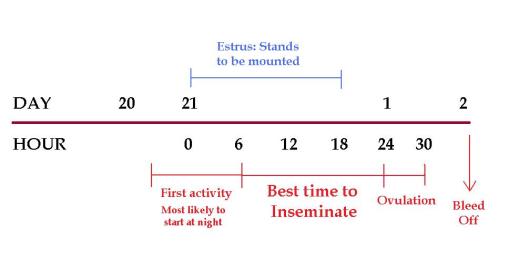 Note: A “bleed-off” occurs in the form of a little blood (you may see it on the cow in fresh or dried form, or you may see it in their bedding where they’ve slept). This does not correlate with whether or not the cow is bred. If you miss seeing signs of a heat, but see the bleed off, you can count back 2 days and mark the calendar as a possible heat.”
Note: A “bleed-off” occurs in the form of a little blood (you may see it on the cow in fresh or dried form, or you may see it in their bedding where they’ve slept). This does not correlate with whether or not the cow is bred. If you miss seeing signs of a heat, but see the bleed off, you can count back 2 days and mark the calendar as a possible heat.”
- How to prepare for the technician:
- Halter and tie your animal or have them in a small nearby pen so they can be caught quickly and easily.
- The breeding location should include a place to securely tie the animal, good lighting, and (optional) access to water and electricity. If you do not have water and electricity nearby, remind your tech to bring warm water and a thermometer.
- A squeeze chute is not required, but having the cow in a stanchion, a stall, or next to a wall is helpful to limit wiggling.
- Be considerate: Avoid muddy or dirty areas (or else remind them to bring boots!)
- Try to have vehicle access as close as possible to where the animal will be bred (as an A.I. tank is very heavy and will stay in the vehicle).
Click on the photo to watch a short A.I. Video on HOW TO BREED A COW USING ARTIFICIAL INSEMINATION
WHAT TO EXPECT AT BREEDING TIME:
If your cow is in ideal condition for breeding and your A.I. tech is close enough to drive over twice, we highly recommend bringing your cow TWO TIMES in one heat cycle. This can highly improve your odds of the cow “taking” to one of the breedings.
EXAMPLE:
- 9 AM – Heat cow jumping, being ridden; call tech
- 6-9 PM – First breeding
Next day:
- 9-11 AM – Second breeding
As a real life example:
A story was shared to me by a friend that she bred her cow to the bull of her choice, the straw was yellow, she bred her that evening.
The next morning, the tech came by again and bred her cow, but she noticed the straw was orange.
Hmm, she thought, why would the same bull have two different colored straws!? Well, luckily she kept both straws and realized the cow had been bred to two different bulls!! She frantically called us and we said she should wait until the calf is born and if a heifer (therefore, going to be registered) she could send in a hair sample to DNA test which bull was the father.
Turns out it was a fun experiment: The DNA results showed that the second bull the cow was bred to was the sire!
OTHER QUESTIONS
HOW LONG DOES IT TAKE TO BREED A COW?
- Tech must warm up water in a heated container to 90 degrees F. The straw is removed from the nitrogen tank and placed in the warm water for one minute to thaw. Meanwhile, the tech must also prepare the pipette and other supplies. This all may take up to 15 minutes, with the thawing of the straw being one of the last steps.
- While the tech is preparing, the owner of the cow can make sure their animal is tied and accessible. Often the tech may have the owner stand next to the cow’s shoulder to help keep the cow from swinging and to talk to the cow gently.
- The actual insemination takes only a few minutes. Once complete, the cow can be left tied for a few minutes or fed some hay to keep her standing and resting.
WHAT WILL BE OBSERVED?
- Most cows will have a clear gooey slick coming from the vulva while the tech is inseminating. This is a good indicator she is in heat.
- Your tech may use words such as “good tone” “heat” “reproductive tract up or close” – those are all positive terms.
- The tech puts their gloved arm in the rear of the cow to remove any manure. They use this arm to feel for the cervix, in order to safely guide the pipette through the three rings of the cervix.
- The pipette is inserted into the vulva, and is carefully slid in further. A pipette is over a foot long, and once inside the cow, only a few inches may be showing on the outside.
- BLOOD: Blood may appear from the rectum or the vulva. The vulva may get lightly scratched by the pipette (this is more likely to happen if the cow is highly agitated or if the tech is new/inexperienced). Blood from the rectum may occur from irritation; this tends to be more likely if the cow’s manure is firm or constipated, as it is more difficult to remove. Remember, around two days after the heat, you may see blood again, called the “bleed off” and this is normal and not necessarily an indicator of whether or not she took to the breeding.
WHAT COMPLICATIONS MIGHT ARISE?
- Constipation – this makes the A.I. process difficult for the tech and should be avoided. Feeding some tender hay, soaked oats or beet pulp, and plenty of fresh tempered water can avoid this issue.
- Wrong timing – Perhaps the signs you saw were not really heat signs, or maybe she is still “too hot” to breed or already “out” of heat. If concerned about this before the breeding, the tech can “arm” the cow and feel around to determine if thawing semen and breeding the cow will be beneficial or not. If not, have the tech return later or wait for the next heat cycle.
- Twisty cervix – Some cows may have had a hard calving and built up scar tissue, other cows may just need more heat cycles to re-align and build up their reproductive system before they are able to breed properly. These cows can often still be bred, but realize that the twists and curves may require more time and skill on the part of the tech.
- Ovarian cyst – For a number of reasons, a cow may develop a cyst, which can either prevent her from showing heats, cause irregular heat cycles, or make her act like she is constantly in heat. A tech or vet should be able to feel and recognize a cyst. The cow will not be able to become pregnant until the cyst is removed. Untreated, a cyst could take several months…or never…clear up. The case of a “lesser evil” is that one hormone treatment may help reset the cow’s system and remove the cyst, allowing her to come back into natural heats. Cystic cows are not rare, so if this happens to your cow, don’t necessarily think it is a trend or the end of the world. Many cows are treated, return to normal, and successfully go on to live many more productive years. Your concern may be warranted only if hormone treatments fail to work or if she repeatedly becomes cystic over the years.
IS IT GUARANTEED MY COW WILL BREED FIRST TRY?
- Don’t we wish! Many cows will become pregnant on the first breeding, if their body is healthy and ready to conceive.
- Second or third breedings are fairly common for cows. If the cow needs to be bred more than that, you may need to re-check the variables:
- Is the cow in good physical health?
- Does the technician seem to be following the rules for timing and prep?
- Is there a possibility the semen is not viable? Any chance the tank ever ran dry?
- Reproductive issues? How does she feel inside? Possible cyst?
- Is it time to consider using more concentrated semen such as beef or young sire?
- Heifers normally take multiple times to breed. A heifer that “takes” after two breedings is a quick breeder. Note, it may be tempting to put the heifer in with a beef herd so a bull can just breed her, but be very careful that if you have a low-birth weight/small breed of animal, and you breed that heifer to a beef bull, you are putting her at high risk of having too large of a calf. For example, breeding a Jersey heifer to a Simmental bull would be super risky.
- Be prepared in advance of the full cost of getting your cow or heifer bred. One breeding at $50 sounds okay, but if you have to have her bred four times, your cost is now $200. That’s still a good deal overall, but some people do better being ready in advance that the cost may multiply.
MY COW IS NOT BREEDING. WHAT CAN I DO TO IMPROVE THE ODDS?
- Try to pinpoint heats and timing as best possible, so the cow can be bred in the right time frame.
- A healthy cow of breeding shape should have a BODY CONDITION (flesh) score of 2.5 to 3.5.
- Avoid constipation or diarrhea – adjust the cow’s feed several days before breeding date.
- If the tech thinks the cow is cystic, has an infection, or has other breeding complications, your best value is to call a vet to come out and check the cow. One vet call may be a lot cheaper than multiple A.I. visits!
- If your cow has suspicious indicators of disease, consider checking with your vet about diseases that may be terminal (Johnes, Bovine Leukosis Virus, etc.) or may cause loss of pregnancy (example: Neospora). Diagnose via blood or manure testing and ask about possible vaccinations.
- Do not assume that one breeding equals pregnancy. This could be a 9 month long mistake. Pregnancy checking is the only accurate way to confirm pregnancy.
- Sexed semen has the least amount of sperm per straw. (Female sperm are centrifugally separated from male sperm. In order to keep cost down, less sperm are put in each straw.) You may have your heart set on getting a heifer, but if the cow has not taken after the second breeding, you may need to really consider whether getting the cow bred in proper time is more important than a heifer. Odds are pretty good with conventional semen: you may get a heifer anyway.
|
Average amount of Semen per straw from least to most (rough estimate) |
|
Embryos |
|
Sexed Semen |
|
Active Sires |
|
Specialty/Rare |
|
Young Sire |
|
Home Collected |
HOW TO TELL SHE IS PREGNANT?
- Count 21 days from date of heat, look for signs of heat then. If you see none, proceed to next steps.
- A drop in milk production may occur. The cow may bounce back some or may not. I have one cow that this is a great indicator of pregnancy, because she reliably breeds on the first try and 20-30 days, bloop: there goes her milk production! In this particular cow, she usually drops ½ to 1 gallon over the next month or two.
- If the cow comes back into heat on an odd date, her body may have tried to hold a pregnancy that was not quite ready to stick. If she comes back in heat more than 21 days up to around 42 days, this may be the case. Consider why she may not have bred (see suggestions above). Try to correct any possible issues and continue breeding when the cow has a good, strong heat.
Pregnancy Check Methods:
Click for article and details on bovine pregnancy tests.
Our Favorite Method:
|
BIOTRACKING |
https://www.biopryn.com/biopryn-affiliate-laboratory-network/ |
| When to take sample: | 28 days or more post breeding + 90 days post calving |
| How is sample taken? | 2cc’s of blood from vein (jugular, milk, or tail). We use a 3cc syringe to draw the blood, and then inject that into a vacu-tainer glass tube.
We are able to buy all the supplies online (3cc syringe + needle and 3cc red top vacutainer tubes) |
| What is the cost? | Mail to lab (we use a small priority shipper for $5.70ish)The lab fee is $2.50 (subject to change at various labs).That’s right, for less than $10!!! |
| How accurate is it? | 99% – We have never had a false positive. |
Other methods:
| RECTAL PALPATION | Contact your local vet |
| When to check: | 5-6 weeks (or more) after breeding |
| How is sample taken? | No sample, the vet is physically feeling for a calf |
| What is the cost? | Vet fees vary, plus mileage (Example: For our vet to come out, it would probably cost around $80-100+) |
| How accurate is it? | Depends on the experience of the vet, some vets have ultrasound available as well, which if done around 50 days post breeding, may be able to tell whether fetus is male or female. |
| Risks? | Risk of miscarriage – We ONLY recommend palpation if blood or milk preg testing is not feasible for you to do AND only if your vet often preg-check cows frequently, with skill. |
| MILK SAMPLE | Idexx Milk Snap Test
http://dairyone.com/analytical-services/pregnancy-testing/ Contact your local DHIA or dairy lab to find out which ones offer this test. |
| When to take sample: | 35 days or more post breeding; 60+ days post calving |
| How is sample taken? | Milk is poured into a tube with preservative. |
| What is the cost? | $5.95 |
| How accurate is it? | up to 98% accurate. |
| URINE STRIPS | http://www.twilcanada.com/bovipreg.php |
| When to take sample: | See website for thorough details |
| How is sample taken? | When cow pees, get a sample directly on stick or pour into a paper cup and put that sample onto stick |
| What is the cost? | $50 for 10 test kits |
| How accurate is it? | over 95% accurate IF done on correctly counted dates, but false results are more likely with this test than with other tests. |
| False positive? | likely depending on timing |
CONGRATULATIONS!
Hopefully by this time, your cow is pregnant and on her way to another successful calving and lactation. For information about drying off your cow & calving: CALVING PREPARATION
Resources:
- Peters, A.R. and P.J.H. Ball, “Reproduction in Cattle.” U.K.: Butterworths Publishers, 1987.
- Campbell, John R. and John F. Lasley, “The Science of Animals that Serve Mankind.” New York: McGraw-Hill Book Company, 1969.
- Hafez, E.S.E., “Reproduction in Farm Animals.” 6th edition, Philadelphia: Lea & Febiger, 1993.

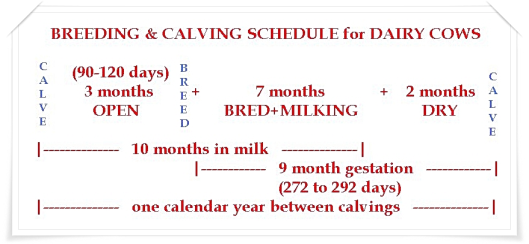
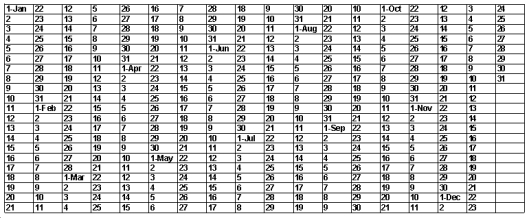
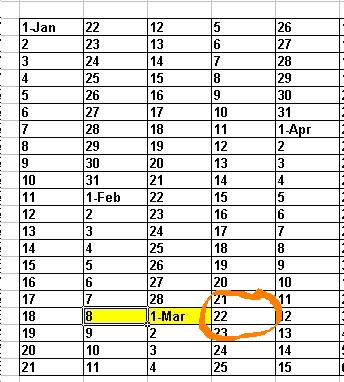
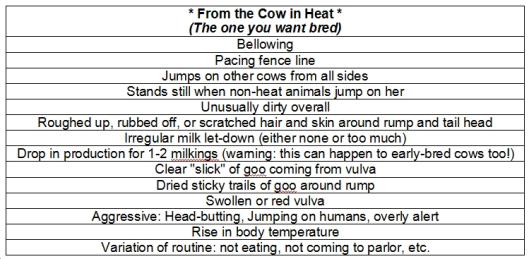

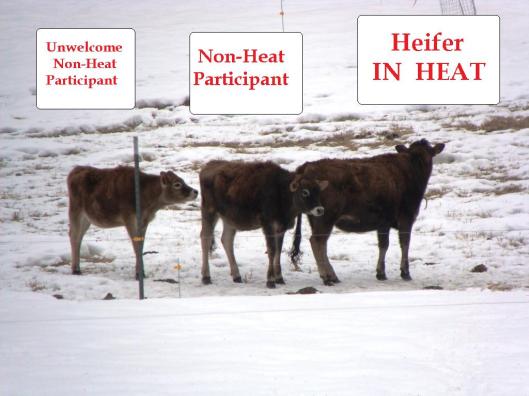
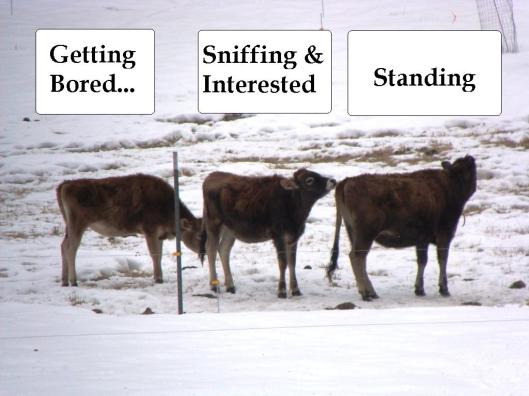
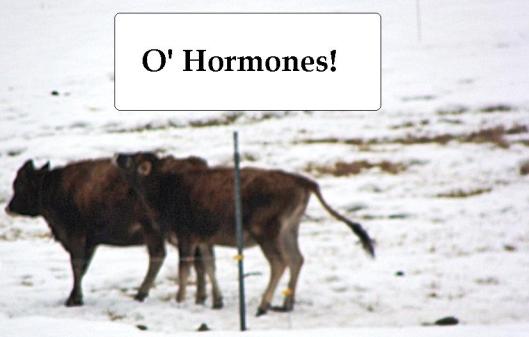
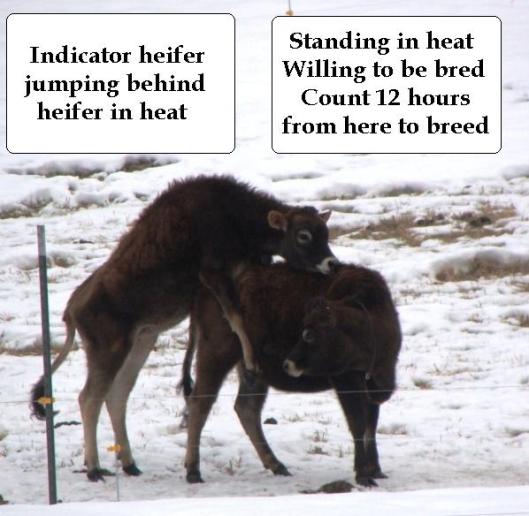
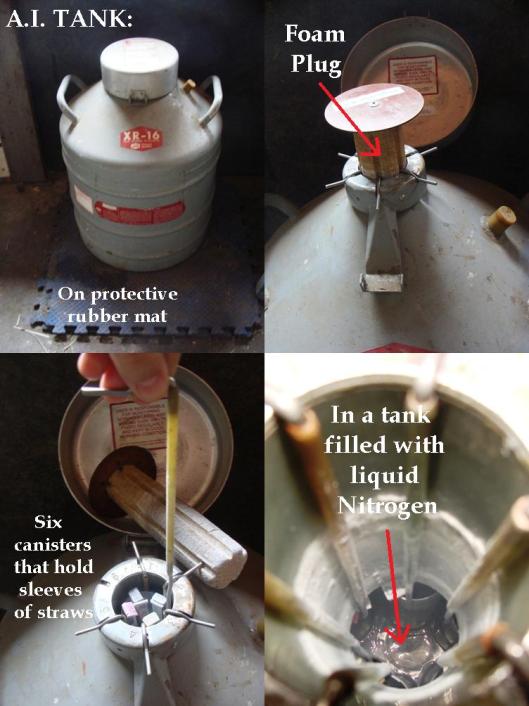
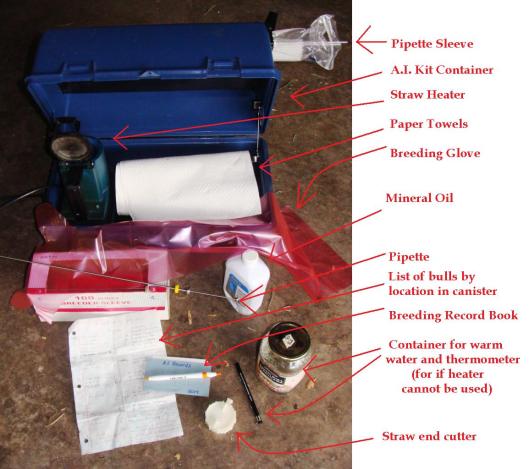
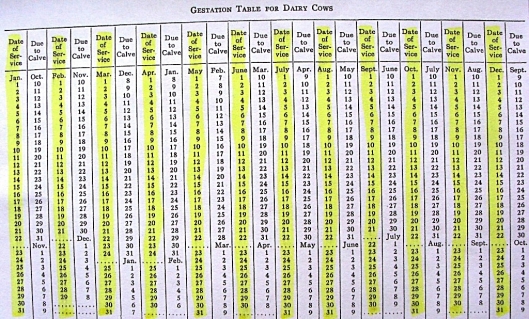
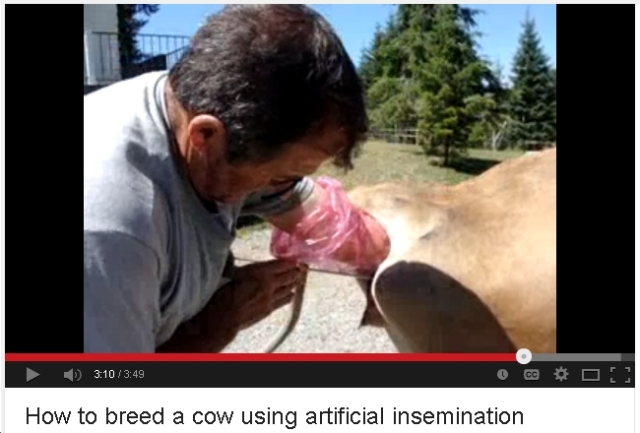
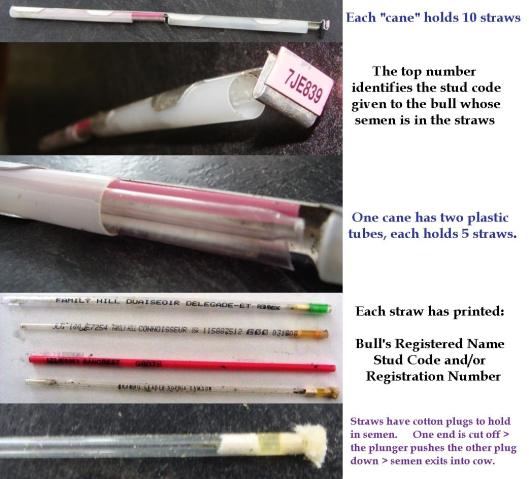
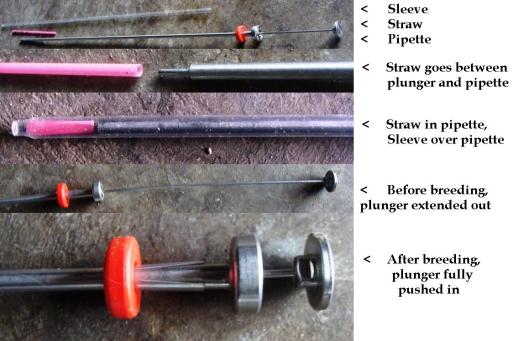

Hello I love all your advise, I bought a 4 year old just freshened Jersey cow, about a month ago, and I don’t have any other cows. There are cows behind us adjoining our property, but that’s 20 acres behind us. I am wandering what to watch for to tell when my Marilyn MooRoe is coming into heat. Of course coming from a dairy and now alone she calls all the time, and stays back there where the other cows are except at milking time, which she comes up for feed.
I would li,e to get her AI, bred, but also have a angus bull right down the road that I have rights for breeding.
Any help here would be appreciated.
LikeLike
Hi,
I have a 14 month old jersey heifer that i am preparing to breed and I was wondering if you perform local AI services? I live about 7 miles south of kettle falls. If you dont, would you know of anyone local that does? Look forward to hearing from you, Thanks!
LikeLike
Molly, I am sending you an email.
LikeLike
Quite educative keep it up !
LikeLike
I love your page:) it gives awesome info. And facts:)))))
LikeLike
This article is very good and educative to a layman. It answers almost all the questions you may want to ask. A very good piece of work was done. Keep it up.
LikeLike